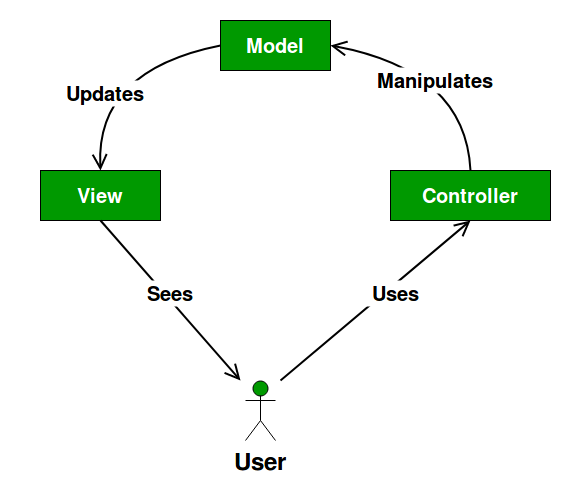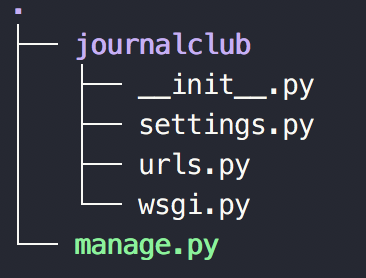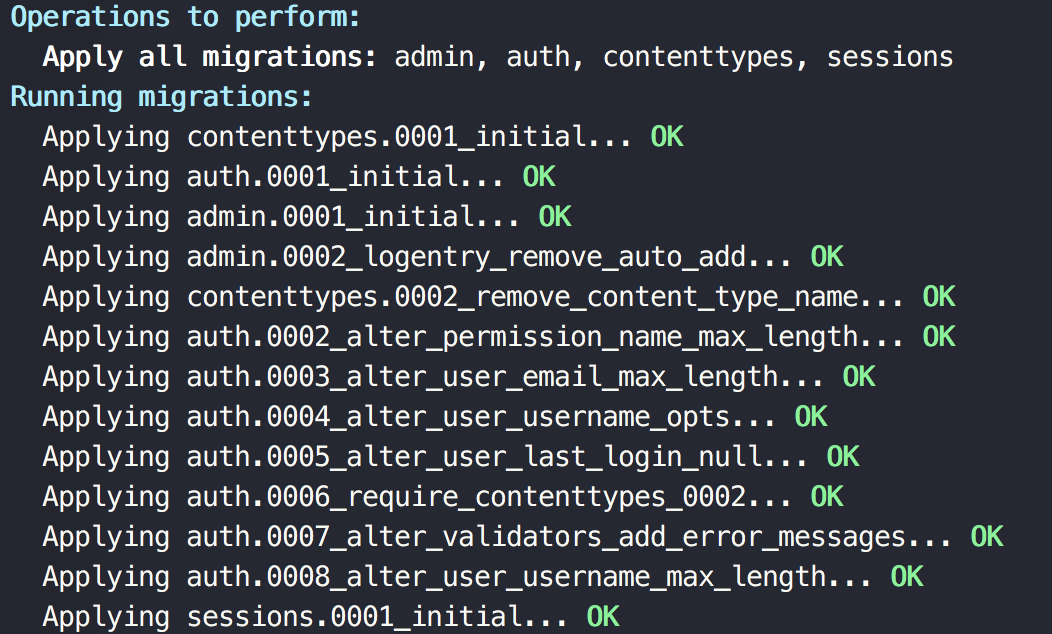Django
[un(-)chained]
This is just an empty slide with speaker notes which y'all can't see

#python2.7
virtualenv env
source env/bin/activate
pip install -r requirements.txt
Linux machines
source env/bin/activate
cd /to/the/project/directory
django-admin.py startproject journalclubYour directory structure will be something like this

Let's make some changes
change ALLOWED_HOSTS = [] to ALLOWED_HOSTS = ['*']
vim journalclub/settings.py
To create a database for our site, let's run the following in the console
python manage.py migrate
Now we can start the web server by running

python manage.py runserver 0:8001http://127.0.0.1:8001/Application
We will create a separate application inside our project
python manage.py startapp blogs| POST |
|---|
| title |
| description |
| author |
| created_date |
| published_date |
Model
from django.db import models
from django.utils import timezone
class Post(models.Model):
author = models.ForeignKey('auth.User')
title = models.CharField(max_length=200)
description = models.TextField()
created_date = models.DateTimeField(default=timezone.now)
published_date = models.DateTimeField(blank=True, null=True)
def publish(self):
self.published_date = timezone.now()
self.save()
def __str__(self):
return self.title
vim journalclub/settings.py
# add blogs to the installed apps- The final step here is to add our new model to our database
- First we have to make Django know that we have some changes in our model. (In this case we have just created it!)
- Go to the console and type the following
python manage.py makemigrations blogs- Django prepared a migration file for us that we now have to apply to our database
- Now type the following
python manage.py migrate blogs- Hurray! Our Post model is now in our database!
- How do i see it?
python manage.py dbshell
# in the sqlite shell
sqlite> .tables
# to see the column names of a table
sqlite> PRAGMA table_info(blogs_post);
# to quit
sqlite>.quitsudo apt-get install sqlite3- Okay so far we have created a application and it's model
- Now that we have a DB to store our posts, how do we actually store values in the table?
- Lets type the following in our console, which will launch an interactive shell
python manage.py shellfrom blog.models import Post
Post.objects.all()
Post.objects.create(author='ambi', title='Sample title',\
description='Test')
How do we query our table and populate values?
from django.contrib.auth.models import User
User.objects.all()
User.objects.create_user(username='test',\
email='ambi@madstreetden.com',\
password='test')me = User.objects.get(username='ambi')
Post.objects.create(author=me,\
title='Sample title',\
description='Test')- We have created multiple posts
- Now lets publish one
post = Post.objects.get(title="Sample title")
post.publish()
Post.objects.filter(published_date__lte=timezone.now())Post.objects.filter(published_date__lte=timezone.now())
Post.objects.filter(published_date__lte=timezone.now()).order_by('published_date')
Post.objects.filter(published_date__lte=timezone.now()).order_by('created_date')Ordering and chaining query sets
Lets exit the interactive shell
URLs
Lets take a look at journalclub/urls.py
from django.conf.urls import include
urlpatterns = [
url(r'^admin/', admin.site.urls),
url(r'', include('blogs.urls')),
]Lets create a urls.py in the blogs app
from django.conf.urls import url
from . import views
urlpatterns = [
url(r'^$', views.post_list, name='post_list'),
]Now lets run the server again

Views
Go into the blogs application and open views.py
from django.http import JsonResponse
def post_list(request):
return JsonResponse({'status': 'okay', 'message': 'pong'},
status=200)But wait this is not what i want
from .models import Post
def post_list(request):
data = Post.objects.all()
fd = []
for x in data:
tmp = {}
tmp['title'] = x.title
tmp['author'] = x.author.username
fd.append(tmp)
return JsonResponse({'status': 'okay', 'message': fd},
status=200)Sending parameters in your HTTP request
from django.contrib.auth.models import User
import traceback, json
def post_create(request):
try:
payload=json.loads(request.body)
username=payload['username']
title=payload['title']
description=payload['description']
me = User.objects.get(username=username)
p=Post.objects.create(author=me, title=title, description=description)
return JsonResponse({'status': 'okay', 'message': '', 'data':{'post_id': p.id}},
status=200)
except:
err = traceback.format_exc()
return JsonResponse({'status': 'okay', 'message': err},
status=500)Adding the respective view to urls.py
Publishing a new post
def publish_post(request):
try:
payload=json.loads(request.body)
post_id = payload['post_id']
p = Post.objects.get(id=post_id)
p.publish()
return JsonResponse({'status': 'okay', 'message': 'Post published',\
'data':{'title':p.title}},
status=200)
except:
err = traceback.format_exc()
return JsonResponse({'status': 'okay', 'message': err},
status=500)Thank you
Templates
def post_list(request):
data = Post.objects.all()
fd = []
for x in data:
tmp = {}
tmp['title'] = x.title
tmp['author'] = x.author.username
fd.append(tmp)
#return JsonResponse({'status': 'okay', 'message': '', 'data':fd},
# status=200)
#return render(request, 'blogs/post_list.html', {})
return render(request, 'blogs/posts_list.html', {'posts': data})
cd applications/templates/applicationname/template.html
Now, Thank you for real
I mean really
Lets get back to work
:)
Django unchained
By ambi
Django unchained
- 638
